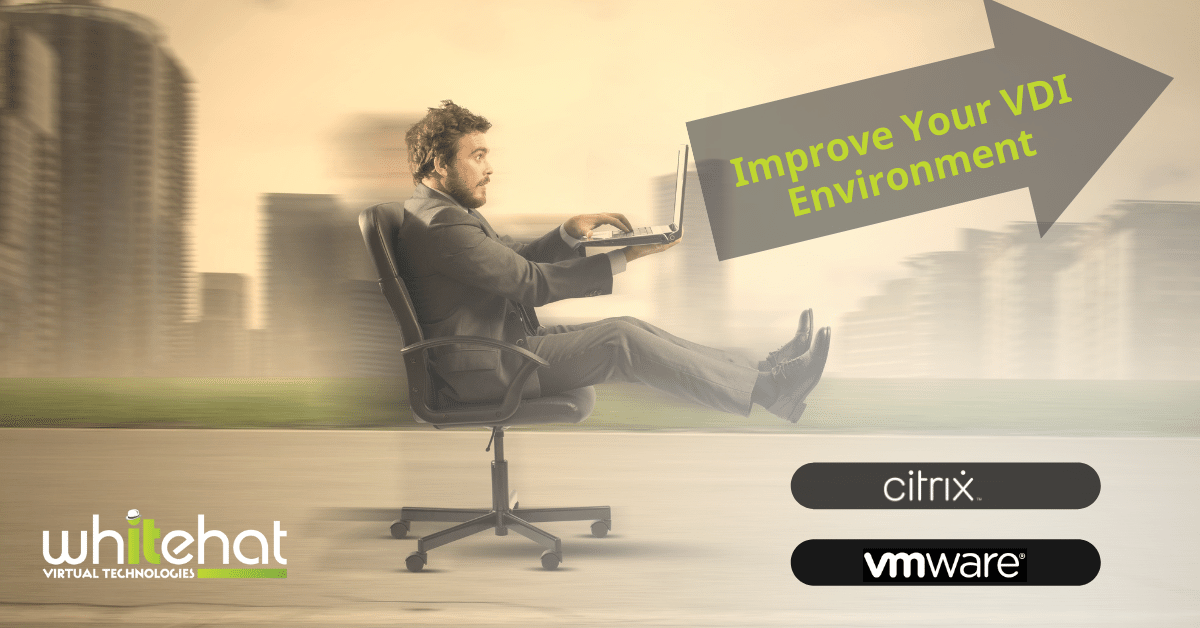How to turn the most ragged, unresponsive Citrix or VMware virtual environment into a slick, responsive system that end-users will love.
As more systems get virtualized and more workloads are delivered from VMware, Citrix, Microsoft and Cloud platforms alike, implementing a fast and effective VDI environment requires more expertise.
In our experience, most problems can be solved using features native to Citrix ADC, Citrix Desktops or VMware Horizon. Not always, but the first place we look is in the configuration environment. Throwing new appliances or software at a VDI environment is common, but in many cases, it's completely unnecessary.
Can your team relate to any of these statements about the current VDI environment?
- Your Citrix or VMware VDI environment is ragged, slow and unresponsive. Users just hate it. They want a slick, responsive system.
- Microsoft Excel performance is SLOW, especially when working with complex macros.
- End-User experience is not good for your remote workforce.
- IT support costs are killing your budget. (See VDI Calculator)
- Your team can't seem to speed up Citrix logon times no matter how much time they spend on troubleshooting.
If so, get a head start and begin troubleshooting with our latest white paper:
Here are a few extra tips to help ensure your VDI Environment is NEVER SLOW:
1. Take a Support Perspective from the Outset, not a Consulting Perspective.
Ongoing support is the IT biggest expense, typically 70% or more of annual IT spend. It’s also the greatest opportunity to maximize the end-user experience and find savings.
Yet designing with the operations team in mind from the outset is a perspective that is frequently missed in the environments we see.
There are thousands of Citrix/VMware consultants out there tinkering away on some of aspect of a Citrix Apps, Desktop or VMware Horizon environment. Nearly all bring a consulting mindset to the task.
What does that mean?
A consulting mindset focuses on getting the environment in good shape today, so it can be pushed to production and closed out. Then the consultant moves to the next project.
On the other hand, a support mindset analyses what’s needed to deliver a consistently good experience not for a day, or even a few weeks, but for years. This perspective looks at the cost of acquisition and deployment plus the cost and effort required to keep the environment running right.
Do you want a Citrix/VMware environment built to last the implementation warranty period, or one built with an understanding of what is going to be required to deliver a consistently great experience for the next five years?
2. Rethink that third-party tooling investment
Third-party tooling is often bundled with an initial deployment.
They sound good. They look good.
While they can do some amazing things, people often overlook the training commitment for each and every member of the Operations team that’s needed to unlock full value.
The result is that they often end up as shelfware.
Shelfware dollars are worse than standing still — they are a step backwards, and the impact is two or even three times the cost of the shelfware product and its implementation when you take into account wasted resources, lost credibility, and the destruction of forward momentum.
Said another way, $1 spent successfully driving new capabilities provides $2 in value. Every dollar that ends up as shelfware is costing you as much as $5.
3. Measure Twice, Spend Once.
Ensure that the architecture and design of your IT investments solve your business problems and are not just an opportunity to follow the herd to the next big thing.
The challenge is that none of this stuff is one-size-fits-all.
There are workloads that make sense for Amazon AWS, Azure, Citrix cloud environments. Then there are workloads that will either underperform there, or that won’t deliver bang for your buck.
No matter how sexy and simple it sounds, the “latest thing” may not be “your thing”.
And when it’s not?
Well, we spend a lot of time helping customers squeeze 2-3 years of value out of legacy equipment that was never going to meet their requirements. These environments are already working at a disadvantage — just trying to get them to tread water takes a lot of resources. Meanwhile, competitors are out there spending dollars and designing a great experience.
Poorly thought out (legacy) purchases can force you into a corner.
It is very easy to slip from being focused on building a great experience that drives productivity and growth, to needing to make the best of a bad situation.
4. Do the math with your own calculator.
The most common problem we must overcome for new customers is hardware that is undersized for its role.
Hardware sizing has to consider your applications — and your unique workflows. Believe me, architecture guides or rules of thumb from 2008 are no substitute for a proof of concept that you’ve tested in your environment. Read the previous point again if you want to understand the potential impact of getting it wrong.
Tempted to pack a user density of 5:1 or more with Windows 10 virtual desktops? Some guides say you can do it, but your end users will not like it.
More, everyone will constantly wonder “Why is Citrix or VMware slow?”
Doing this is the equivalent of trying to suck a Wendy’s Frostee (or a thick shake for those that have not had the experience) through a coffee straw. All you’re going to get is red in the face with very little chocolaty goodness to show for it.
Remember, your results may vary for a set hardware configuration. Calculate what your results need to be before buying something very expensive that you can’t change for the next five years.
We go over this relentlessly with new customers, testing numerous configurations until we find an easily managed setup that maximizes end user experience.
If you're using VMware Blast Extreme and you think it's related to your slow environment, download our optimization guide:  5. Optimize everything.
5. Optimize everything.
The best-performing VDI and virtual application environments are ones that recognize the need to optimize the 13 or so different systems that interact in delivering the right published applications or virtual desktop experience.
Many systems are not configured for virtualized environments or set up as "VDI in a box"; settings must be adjusted per use case. Whitehat has cataloged 540+ optimizations that we deploy with every environment we manage.
A free tip: Never, ever use Power Save Mode or the same feature by any other name in your servers. You are just limiting yourself. Max resources, all the time or get ready to answer the “why can’t we get more VDI users per box?” question.
6. Take off the blindfold, you will see a lot better.
VDI environments can seem expensive to build. I would argue that there might be a different perspective if we could actually see sixty or so desktops being crammed into one server but that’s another article.
Because VDI is never going to be bought at the dollar store, there can be a tendency to cut costs by skimping on “fringe extras” such as management tools.
This sounds fiscally responsible on paper, but it can be a bit misguided. You would not let your beloved grandfather buy a new car and skip out on buying the eyeglasses he needs to see the steering wheel, let alone the road.
Yet organizations constantly do the equivalent with their virtual environments. Then they wonder why it takes so long to diagnose and fix problems.
There are fistfuls of management tools out there that all claim to be the best. Some are good at helping you find issues, some are better at overall management, some are crazy-expensive, and some are too complex for their own good.
We’ve been through most of them over the years and now bring our own just to keep it simple. If something better comes along, we can switch without contributing to a customer’s pile of shelfware.
7. Complexity is not your friend.
There is a tool to do just about anything in virtual desktop environments and a sales guy to sell it to you.
In a word, resist.
Most problems can be solved for the low, low price of nothing using features native to Citrix Apps, Citrix Desktops or VMware Horizon.
Not always, but our recommendation is that it’s the first place to look as “free” is always in the budget.
We use a small number of tools for giving us visibility into the environment, automating issue identification, remote access and resolution, and profile/application management.
Very simple. Very small footprint.
If your Citrix or VMware environment looks more like Tin Cup’s strategy to improve his golf game than Tiger’s, there are likely some zero dollar savings and efficiencies to be found in your environment.
8. It is all about the Applications.
More than some new technology or trend, your applications are going to tell you to some degree where and how your virtual desktop environment should run.
We find that 80% of a typical application set will work just about anywhere. The remaining 20% will set some of the rules about how your environment must be architected and what the support burden is going to be like going forward.
9. More images = greater support costs (and opportunities for inconsistent end user experience).
Every additional image increases support costs. As a rule, we don’t want more than three images. Individual use cases vary, of course, but we find this rule works 90% of the time.
If you are experiencing challenges with a Citrix or VMware environment and need some help, want to talk about best practices managing virtual environments, or are ready to get the benefits VDI without the uncertainty and management overhead, get in touch:
Need more information or help?







Leave Comment